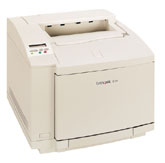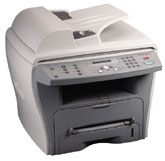|
|


TechnoFILE is copyright and a registered trademark © ® of
Pandemonium Productions.
All rights reserved.
E-mail us Here!

Lexmark Printer Duo offers Power, FlexibilityBy Jim Bray I’ve wanted to try a color laser printer for ages. After all, inkjets are fine, and they do an excellent job, but they suck back ink as if it were going out of style whereas laser printers are far less toner thirsty – as long, traditionally, as you’re happy with black and white. So Lexmark sent TechnoFile its C720 color laser, a networkable machine that starts at a measly $829US (for a non-networked version) and offers darn good quality. Okay, that’s still a lot more expensive than many inkjet printers, which are now so cheap they may as well just give them away in cereal boxes, but for a color laser it’s pretty remarkable. They also sent us the X215, a multifunction device similar in concept to those all-in-one inkjet printers you’ve undoubtedly seen in stores for years. Except that this one isn’t an inkjet – it’s a monochrome laser printer. This means you lose the capability for color in this particular device, but you gain lower operating costs by getting rid of the ink cartridge replacement conundrum. Anyway, back to the C720. Lexmark says it offers up to 24 ppm (pages per minute) in monochrome (black) and 6 in color. These, of course, are best case scenarios and your mileage may vary. I never timed the printer’s performance but don’t believe I ever got that close. It was hard to tell, though; we had the printer installed in our network room – on the network – and I always managed to find better things to do than run downstairs and stand there with a stopwatch, waiting "for my prints to come." That said, one doesn’t really get into these printers for blinding speed; quality is far more important. And in this case, the C720 works just fine. Print resolution is 600x600 dpi (dots per inch), with electronic fudging allowing up to 2400 dpi. This is a common spec, and it’s quite misleading because for most print jobs the native 600x600 is more than adequate. I found the print quality to me just fine, thank you, though I was never happy with its performance on photographs. As it turned out, this was my own fault. Not thinking, I loaded photo paper meant for inkjet printers and the results were awful. This is because inkjet paper and laser paper are different beasts: lasers use heat to apply the toner to the page, while inkjets – as the name implies – spray the ink. And the inkjet paper disintegrates under the heat of the laser printer, so we ended up with parts of the paper being stripped from the top part of the page and deposited again on the bottom part, ruining both. And hopefully not ruining the interior of the printer! I did try color prints using better paper but it still wasn’t up to the quality of inkjet on photo paper – and by the time I had all this figured out it was time to send the printer back and so I never did get some laser photo paper to try it with. Lexmark had sent a couple of demo shots with the printer, however, and they looked very good indeed – though of course one should always take demos with a grain of salt. Anyway, the printer is relatively large, since it takes four separate toner cartridges and you have to put them somewhere, and is a bit of a pain to set up because of that, but once you (or your IT people) have gone through that rigmarole it works very well. Media types include paper (well, duh!), envelopes, transparencies, labels and the like, and it’ll print up to legal size sheets. Bottom line is that this is an affordable color laser printer that brings that wonderful world within reach of home offices and small to medium sized businesses who need color capability but who can’t afford the really heavy duty models. 
The other printer, the X215 all in one, really surprised me. It’s Lexmark’s first entry into the low end laser MFP market, as well as its first sub $500US networkable multifunction printer that comes standard with an automatic document feeder and high speed fax. Whew. And you know, I had expected to have my socks knocked off by the color laser and a “yeah, so what?” attitude about the MFP. But it was the MFP that I really fell in love with! I loved its MFP capabilities, its excellent scanner, and the abovementioned document feeder. The X215 is straightforward; it’s easy to set up and use and works pretty much as advertised. Its faxing capabilities are the least of my concerns, since I rarely use any type of fax any more (though it's nice to have the capability), but the other features more than make up for the unit's price – a price that’s quite reasonable to start with. As a printer/copier/scanner, the X215 offers 600x600 dpi quality and up to 17 ppm performance. As a scanner, it’s a flatbed unit with the document feeder mounted on the lid – and it works extremely well in both configurations. Lexmark says it interpolates up to 4800x4800 dpi as a scanner. I was more impressed by its scanning performance than anything else (though it works as advertised in each of its functions) and after I’d packed it up and sent it back and gone back to my old scanner I really missed it. The X215 has a small enough footprint to fit right where my small color inkjet usually sat, and hardly took up any more room. It’s a lot taller, though, and this meant I had to stand to use its control panel – but this was not only not a big deal (and depending on your desktop your experience may differ) but it actually got me off my butt periodically during the day! Anyway, hookup and setup of the X215 is very easy. I used it via USB and that worked very well. Image handling features include reduction and enlargement from 25 to 400 per cent, which comes in handy at times, and of course despite the fact that its output is monochrome you can scan in color and send the images to your PC. The printer/thingy comes with PaperPort SE scanning software and it works fine. Even better, it worked seamlessly with my Pagis software coupled with TextBridge Pro. I used it to scan pages from the textbooks used in a writing course I was teaching at the time, sending it to the OCR (optical character recognition) to turn it back into editable text. It worked very well. Bottom line? I really liked this all in one beastie – far more than I ever expected I would. Lexmark deserves kudos for coming up with a machine this flexible and with this level of performance at this price.
|
|
|
|
|
| Support TechnoFile via Paypal |
| TechnoFILE's
E-letter We're pleased to offer our FREE private, subscription-based private E-mail service. It's the "no brainer" way to keep informed. Our Privacy Policy |